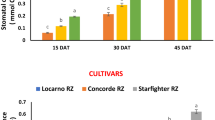Abstract
A pot experiment was conducted to study the effects of root pruning at the stem elongation stage on the growth and water use efficiency (WUE) of winter wheat (Triticum aestivum). The results showed that stomatal conductance (g) and transpiration (E) of wheat were very sensitive to root pruning. After root pruning, they declined rapidly and but returned to pre-pruning values 15 days after treatment. Under well-watered conditions, there was no significant difference in leaf water potential (ψleaf) between root pruned and control plants after root pruning. Under moderate drought stress, ψleaf of root pruned plants declined significantly compared to the control 3 days after root pruning. After 15 days, ψleaf of root pruned plants was similar to the controls. Under different soil moisture levels, net assimilation rate (A) of root pruned plants was lower than controls 3–7 days after root pruning, but was similar to the controls 15 days after pruning. At anthesis (50 days after root pruning), root pruned plants showed significantly higher A compared with the control. Leaf area per tiller and tiller number of root pruning plants was significant lower than the control at booting stage, which showed that root pruning restrained the growth of plants in the early growing stage, but leaf area per stem, of root pruned plants, was similar to the control at anthesis. Under both soil moisture levels, there was no significant difference in grain yield between root pruned and the control plants in the monoculture. In mixture with the control plants, the root pruned plants was less productive and had a lower relative yield (0.92 and 0.78, respectively) compared with the control (1.13 and 1.19, respectively), which suggested that the pruned plants lost some of its competing ability and showed a lower ability to acquire and use the same resources in the mixture compared with the control plant. Over the whole growing cycle, root pruning reduced water consumption (by 10% under well-watered conditions and 16% under moderate drought stress) of wheat significantly compared to the control (P < 0.05), and but there was no significant difference in grain yield between root pruned and control plants. Therefore root pruned wheat had a higher WUE with respect to grain yield compared with the controls. In conclusion, lowering water consumption by root pruning in the early growing stage is an effective way to improve water use efficiency in arid and semi arid areas.



Similar content being viewed by others
References
Blackman PG, Davies WJ (1985) Root-to-shoot communication in maize plants of the effects of soil drying. J Exp Bot 36:39–48. doi:10.1093/jxb/36.1.39
Caldwell MM (1987) Competition between root systems in natural communities. In: Gregory PJ, Lake JV, Rose DA (eds) Root development and function. Cambridge University Press, Cambridge, pp 167–185
Cinnirella S, Magnani F, Saracino A, Borghetti M (2002) Response of a mature Pinus laricio plantation to a three-year restriction of water supply: structural and functional acclimation to drought. Tree Physiol 22:21–30
Cooper DJ, D’Amico DR, Scott ML (2003) Physiological and morphological response patterns of Populus deltoides to alluvial groundwater pumping. Environ Manag 31(2):215–226. doi:10.1007/s00267-002-2808-2
Davis WJ, Zhang J (1991) Root signals and the regulation of growth and development of plants in drying soil. Annu Rev Plant Physiol Plant Mol Biol 42:55–76. doi:10.1146/annurev.pp.42.060191.000415
de Wit CT (1960) On competition. In: Verslagen van landbouwkundige onderzoekingen, vol 66. Wageningen, pp 1–81
Dennison RF, Kiers ET, West SA (2003) Darwinian agriculture: when can humans find solutions beyond the reach of natural selection? Q Rev Biol 78:145–168. doi:10.1086/374951
Donald CM (1968) The breeding of crop ideotype. Euphytica 17:385–403. doi:10.1007/BF00056241
Donld C, Hamblin MJ (1983) The convergent evolution of annual seed crops in agriculture. Adv Agron 36:97–1436. doi:10.1016/S0065-2113(08)60353-3
Gallardo M, Turner NC, Ludwig C (1994) Water relations, gas exchange and abscisic acid content of Lupins cosentinii leaves in response to drying different proportions of the root system. J Exp Bot 45:909–918. doi:10.1093/jxb/45.7.909
Gaudet CL, Keddy PA (1988) A comparative approach to predicting competitive ability from plant traits. Nature 334:242–243. doi:10.1038/334242a0
Gregory PJ, Simmonds LP, Pilbeam CJ (2000) Soil type, climatic regime, and the response of water use efficiency to crop management. Agron J 92:814–820
Howell TA (2001) Enhancing water use efficiency in irrigated agriculture. Agron J 93:182–289
Hurd EA (1974) Phenotype and drought tolerance in wheat. Agric Meteorol 14:39–45. doi:10.1016/0002-1571(74)90009-0
Jackson M (1993) Are plants hormones involved in root to shoot communication? In: Callow JA (ed) Advanced in Botanical Research, vol 19. Academic Press, London, pp 103–187
Jastrow JD, Miller RM (1993) Neighbor influences on root morphology and mycorrhizal fungus colonization in tall grass prairie plants. Ecology 72:561–569. doi:10.2307/1939316
Jin MG, Zhang RQ, Gao YF (1999) Temporal and spatial soil water management: a case study in the Heiloonggang region, PR China. Agric Water Manag 42:173–187. doi:10.1016/S0378-3774(99)00039-6
Jones HG (1993) Water use efficiency. In: Smith AJC, Griffiths H (eds) Water deficits. Bios, Oxford, pp 193–203
Kang SZ, Zhang L, Liang YL, Hu XT, Cai HJ, Gu BJ (2002) Effects of limited irrigation on yield and water use efficiency of winter wheat in the Loess Plateau of China. Agric Water Manag 55:203–216. doi:10.1016/S0378-3774(01)00180-9
Kramer PJ (1969) Plant and soil water relationships: a modern synthesis. McGraw Hill, New York, p 482
Li LH, Chen SB (2002) Study on root function efficiency of spring wheat under different moisture condition. Sci Agric Sin 35:867–871 (in Chinese with English abstract)
Li FM, Zhao SL (1997) New approaches in researches of water use efficiency in semiarid area of Loess Plateau. Chin J Appl Ecol 8:104–109 (in Chinese with English abstract)
Li FM, Liu XL, Li SQ (2001) Effects of early soil water distribution on the dry matter partition between roots and shoots of winter wheat. Agric Water Manag 49:163–171. doi:10.1016/S0378-3774(01)00088-9
Li YY, Zhang SQ, Shao MA (2003) Interrelationship between water use efficiency and nitrogen use efficiency of different wheat evolution materials. Chin J Appl Ecol 14:1478–1480 (in Chinese with English abstract)
Liu CM, Zhang XY, Zhang YQ (2002) Determination of daily evaporation and evapotranspiration of winter wheat and maize by large-scale weighing lysimeter and micro-lysimeter. Agric For Meteorol 111:109–120. doi:10.1016/S0168-1923(02)00015-1
Reynolds MP, Acevedo E, Sayre KD, Fischer RA (1994) Yield potential in modem wheat varieties: its association with a less competitive ideotype. Field Crops Res 37:149–160. doi:10.1016/0378-4290(94)90094-9
Shan L (2002) Development trend of dry-land farming technologies. Sci Agric Sin 35:848–855 (in Chinese with English abstract)
Siddique KHM, Belford RK, Tennant D (1990) Root: shoot ratio of old and modern, tall and semidwarf wheat in a Mediterranean environment. Plant Soil 121:89–98. doi:10.1007/BF00013101
Sobeih WY, Dodd IC, Bacon MA (2004) Long-distance signals regulating stomatal conductance and leaf growth in tomato (Lycopersicon esculentum) plants subjected to partial root-zone drying. J Exp Bot 55:2353–2363. doi:10.1093/jxb/erh204
Vysotskaya L, Timergalina L, Simonyan M, Veselov S, Kudoyarova G (2001) Growth rate, IAA and cytokinin content of wheat seedlings after root pruning. Plant Growth Regul 33:51–57. doi:10.1023/A:1010700617829
Wang YY, Zhou R, Zhou X (1994) Endogenous levels of ABA and cytokinins and their relation to stomatal behavior in dayflower (Commelina communis L.). J Plant Physiol 144:45–48
Wang HB, Wang XC, Lou CH (1999) Relationship between acetylcholine and stomatal movement in Vicia faba. Acta Bot Sin 41(2):171–175 (in Chinese with English abstract)
Weiner J (2003) Ecology-the science of agriculture in the 21st century. J Agric Sci 141:371–377. doi:10.1017/S0021859603003605
Zhang DY, Jiang XH (2000) An ecological perspective on crop production. Acta Phytoecol Sin 24(3):383–384 (in Chinese with English abstract)
Zhang DY, Sun GJ, Jiang XH (1999) Donald’s ideotype and growth redundancy: a game theoretical analysis. Field Crops Res 61:179–187. doi:10.1016/S0378-4290(98)00156-7
Zhang SQ, Shan L, Deng XP (2002) Relation between growth of root system and water use efficiency during the evolution process. Chin Sci Bull 47:1327–1331 (in Chinese with English abstract)
Zhang XY, Pei D, Chen SY (2004) Root growth and soil water utilization of winter wheat in the North China Plain. Hydrol Process 18:2275–2287. doi:10.1002/hyp.5533
Acknowledgements
The authors thank Ms. Lin Liu and Xiao-hong Zhang and Mr. Sheng-jiao Yang for their assistance in the experiment. This research was supported by “Hundred-Talent Program” of Chinese Academy of Sciences (C24016200) and National “973’’ Project (2007CB106804).
Author information
Authors and Affiliations
Corresponding author
Rights and permissions
About this article
Cite this article
Ma, SC., Li, FM., Xu, BC. et al. Effects of root pruning on the growth and water use efficiency of winter wheat. Plant Growth Regul 57, 233–241 (2009). https://doi.org/10.1007/s10725-008-9340-1
Received:
Accepted:
Published:
Issue Date:
DOI: https://doi.org/10.1007/s10725-008-9340-1




